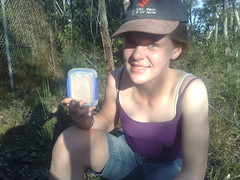I’ve been in a few conference presentations lately where the topic of geocaching has come up. Usually, the presenter asks the question “who knows about geocaching?” and about three hands go up. The presenter then tries to give a quick explanation about it for those who haven’t heard about it – “it’s like a treasure hunt”, or “it’s a game where people hide things for others to find”, or other similar explanations. While these summaries are mostly accurate, they don’t really give enough information and many people seem interested to know more about it.
Thanks to a long involvement with 4WDing, I’ve been playing with GPS and digital mapping for a while now, and I’ve done quite a bit of geocaching over the last few years, including placing our own. When I started I was using a Garmin GPS V, a great little GPS that can basically do it all – multiple datum switching, realtime path tracking, waypoint extrapolation – you name it, it does it. Trouble is, it’s not connected to the web, so “going geocaching” had to be a preplanned activity. I had to look up geocaches in advance on the official website at www.geocaching.com, print out all the information sheets, and then manually enter the GPS coordinates into the Garmin. Once the cache was found, when I got back home I had to go back to the website to report the cache found.
Lately, I’ve been having a lot of fun with a terrific little iPhone app called, simply, Geocaching. On the 3G connected and GPS enabled iPhone, you can pull the device out of your pocket, press the Find Nearby Caches button and it will take your current GPS coordinates, go to the website and find all the nearby caches. Pick one, and the app will grab all the relevant data, draw a map, plot your position and the position of the cache, give you a compass to guide you, and it will lead you right to the cache. Once you find it, you have the ability to report the find directly in the app, making it a seamless end-to-end experience. Although the iPhone app lacks some of the more sophisticated features that a “real” GPS offers, the convenience factor that comes from being able to do the vast majority of geocaches anywhere, anytime, without any special preparation, makes up for these shortcomings. It’s not free, but for me, has been well worth the $12.99 it cost me on the Apple app store.
Linda and I were out walking today so, geeks that we are, I pulled the iPhone out and did a quick search to find that there were two caches within 500 metres of where we were. We found them both of course, but on the second one, I made this short video that hopefully explains a little more about geocaching and how it works.
If you haven’t tried geocaching yet, give it a go. It gets you out into the fresh air, is an interesting use of technology, and most of all it’s great fun. I reckon it offers some terrific opportunities in education, and is a way to integrate technology in a really hands-on way that brings a whole lot of skills together – mapreading, fitness, resourcefulness, even a bit of maths. I’ve always had a hard time getting it introduced into schools because a class set of GPS units can be a bit expensive, but with the development of apps like Geocaching for the iPhone (and similar apps for other devices, such as Geocache Navigator on Nokia S60 phones) maybe it’s not such a stretch for kids to have these tools on their own phones instead.
What’s that? What do you mean your school bans phones!?

 A while back, I went
A while back, I went